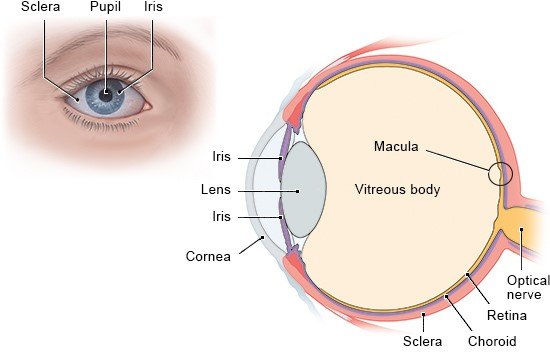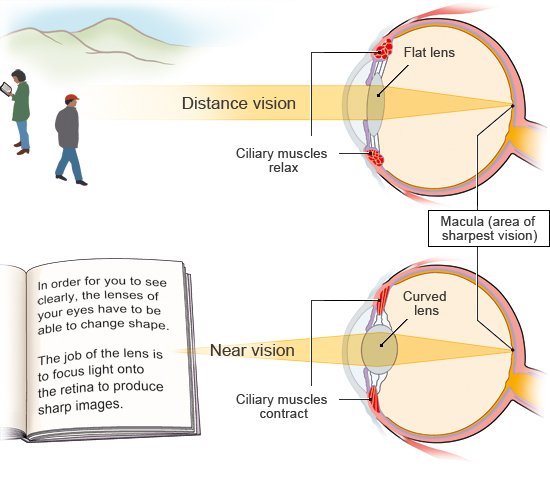Vision is the result of a complex process. For our brain to be able to create an image of our surroundings, the eye needs to convert light into electrical signals called nerve impulses. These nerve impulses then travel to the brain along the optic nerve. The different parts of the eye each have special, closely coordinated jobs. The main parts of the eye are
The front part of the eye
The white part of the eye (sclera) is the visible part of the firm outer surface of the eyeball. The colored part of the eye is the iris. It is like a disc with a hole in the middle, which is known as the pupil. The iris has muscles that it can use to make the pupil bigger or smaller. A bit like the aperture of a camera, this controls how much light is let into the eye: When it’s very bright, the iris makes the pupil smaller to prevent “overexposure.” In the dark, the iris makes the pupil bigger to let as much light as possible enter the eye.
The iris and pupil are covered by a transparent layer called the cornea. The main function of the cornea is to protect the eye from foreign objects and injury. Our eyelids, eyelashes and tear fluid do this too. But the cornea also plays a role in vision. It changes the path of the light (refracts the light) on its way into the eye.
The cornea isn't located right on the iris. Instead, it is stretched over it like a dome. The space inside this dome contains a fluid called aqueous humor. This fluid cleanses the eye and supplies the cornea and lens with nutrients.
The inside of the eye
When rays of light pass through the pupil, they reach the lens right behind it. The lens is attached to muscles through strong fibers. When these muscles contract, the shape of the lens changes. The path of the light entering the eye is then changed (refracted) to different extents depending on the shape. This process, known as “accommodation,” allows the eye to focus on nearby or more distant objects.
The vitreous body is located behind the lens. This gel-like mass gives the eyeball its full, elastic shape. The vitreous body is transparent, like the cornea and the lens. This is an important requirement for good vision. But vision may become cloudy in old age: For example, if the lens is no longer “crystal clear,” it’s known as a cataract. The cornea can also become cloudy in older people. This may be caused by scarring.
Many people have cloudy substances in their vitreous body that are harmless and don’t affect how your vision functions. Sometimes it can seem like small threads or insects are floating around in your field of vision, though. These are called eye floaters. Sometimes the vitreous body becomes so cloudy that it affects your vision and needs to be treated. But this is less common and is usually associated with an eye infection. The vitreous body can also become cloudy if blood enters the eyeball. The inside of the eyeball is lined with a membrane called the retina. In the back part of the eye – called the ocular fundus – the retina contains millions of sensory cells. The refraction caused by the lens makes a sharp image of whatever you are looking at appear right there. The sensory cells receive these light signals and convert them to nerve signals.
The retina has two kinds of sensory cells, called cones and rods.
- The cones allow us to see in color.
- The rods are responsible for “black and white” vision. They need less light and make it possible for us to see at dusk and at night.
These different kinds of sensory cells aren’t evenly spread out across the retina. Most of the cones are located roughly in the middle of the ocular fundus, which is called the macula. This is the area in which our vision is the sharpest.
The nerve signals sent by the cones and rods are carried to the brain by the optic nerve. In the brain they are processed and used to create a consciously perceived image, together with information from the other eye.
Brandes R, Lang F, Schmidt R. Physiologie des Menschen: mit Pathophysiologie. Berlin: Springer; 2019.
Menche N. Biologie Anatomie Physiologie. Munich: Urban und Fischer; 2023.
Pschyrembel Online. 2025.
IQWiG health information is written with the aim of helping people understand the advantages and disadvantages of the main treatment options and health care services.
Because IQWiG is a German institute, some of the information provided here is specific to the German health care system. The suitability of any of the described options in an individual case can be determined by talking to a doctor. informedhealth.org can provide support for talks with doctors and other medical professionals, but cannot replace them. We do not offer individual consultations.
Our information is based on the results of good-quality studies. It is written by a team of health care professionals, scientists and editors, and reviewed by external experts. You can find a detailed description of how our health information is produced and updated in our methods.
Stay informed
Subscribe to our newsletter or newsfeed. You can find our growing collection of films on YouTube.


